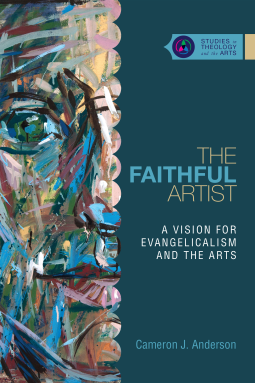
The Faithful Artist
A Vision for Evangelicalism and the Arts
by Cameron J. Anderson
This title was previously available on NetGalley and is now archived.
Buy on Amazon
Buy on BN.com
Buy on Bookshop.org
*This page contains affiliate links, so we may earn a small commission when you make a purchase through links on our site at no additional cost to you.
Send NetGalley books directly to your Kindle or Kindle app
1
To read on a Kindle or Kindle app, please add kindle@netgalley.com as an approved email address to receive files in your Amazon account. Click here for step-by-step instructions.
2
Also find your Kindle email address within your Amazon account, and enter it here.
Pub Date Nov 07 2016 | Archive Date Dec 28 2016
InterVarsity Press | IVP Academic
Description
In this latest volume in IVP Academic’s
Studies in Theology and the Arts series, Cameron Anderson lays out a vision for
how Christian artists can faithfully pursue their vocational calling in
contemporary culture.
Drawing on his experiences as both a Christian and a practicing artist, Anderson traces the relationship between evangelicalism and modern art in postwar America—two entities that often found themselves at odds with each other. With skill, sensitivity and insight, he considers the role of our bodies and our senses in our experience of the arts, the relationship between text and image, the persistent dangers of idolatry, the possibility of pursuing God through an encounter with beauty, and more. Readers will find here not only informed and thoughtful responses, but also a vision that offers guidance and hope, dispelling the false choice between Christianity and the arts.
Drawing on his experiences as both a Christian and a practicing artist, Anderson traces the relationship between evangelicalism and modern art in postwar America—two entities that often found themselves at odds with each other. With skill, sensitivity and insight, he considers the role of our bodies and our senses in our experience of the arts, the relationship between text and image, the persistent dangers of idolatry, the possibility of pursuing God through an encounter with beauty, and more. Readers will find here not only informed and thoughtful responses, but also a vision that offers guidance and hope, dispelling the false choice between Christianity and the arts.
Advance Praise
"Anderson . . . clarifies for Christians why art still matters in the
midst of tensions between traditional religious belief and modern
aesthetic sensibility—issuing a compelling call for artists to
rediscover their accountability and calling within the body of Christ,
broken afresh for the life of the world. Additionally he makes a vital
argument for why the church needs art and artists, providing genuine
answers for how these might once again find their way into healthy
communion with one another."
—Bruce Herman, Lothlorien Distinguished Chair in Fine Arts, Gordon College
"This is a thoughtful, remarkable book that will help evangelical Christians face their history of shunning modern art. As a convinced follower of Jesus Christ, Anderson lovingly laments the past evangelical practice of pitting binary opposites against one another: soul against body, word against image, church ministry against being an artist. Anderson shows how the millennia of church history and a fresh biblical stance can overcome these polarities. Through his writing, which is extremely well researched and gives evidence of many years of wide reading, he convincingly shows how visual culture can be central to piety and how artistry is a worthy occupation for believers. This work is exciting, people friendly, deeply faithful and wise."
—Calvin Seerveld, professor emeritus of philosophical aesthetics, Institute for Christian Studies, Toronto
"Cam Anderson's vision inspires, challenges and encourages me. He is wise about creativity, faithful about imagination and provocative about beauty. We are invited into a deeper humanity and a greater faithfulness to the Artist who made us. I am so grateful for this book and believe many other readers will be too!"
—Mark Labberton, president, Fuller Theological Seminary
—Bruce Herman, Lothlorien Distinguished Chair in Fine Arts, Gordon College
"This is a thoughtful, remarkable book that will help evangelical Christians face their history of shunning modern art. As a convinced follower of Jesus Christ, Anderson lovingly laments the past evangelical practice of pitting binary opposites against one another: soul against body, word against image, church ministry against being an artist. Anderson shows how the millennia of church history and a fresh biblical stance can overcome these polarities. Through his writing, which is extremely well researched and gives evidence of many years of wide reading, he convincingly shows how visual culture can be central to piety and how artistry is a worthy occupation for believers. This work is exciting, people friendly, deeply faithful and wise."
—Calvin Seerveld, professor emeritus of philosophical aesthetics, Institute for Christian Studies, Toronto
"Cam Anderson's vision inspires, challenges and encourages me. He is wise about creativity, faithful about imagination and provocative about beauty. We are invited into a deeper humanity and a greater faithfulness to the Artist who made us. I am so grateful for this book and believe many other readers will be too!"
—Mark Labberton, president, Fuller Theological Seminary
Available Editions
| EDITION | Paperback |
| ISBN | 9780830850648 |
| PRICE | $26.00 (USD) |
| PAGES | 290 |
Average rating from 3 members
Featured Reviews
 Agnes P, Reviewer
Agnes P, Reviewer
This is a very profound and richly documented study that analizes the reasons of antagonism between Church (especially Evangelical) and the art world (mostly secular), quoting artists, art historians, philosophers and religious sources. This antagonism has diminuished a lot since the author has choosen to study art (some decades ago), a very courageous decision at that time. In the book he treats with great sincerity and seriousness important questions that a person with faith and a calling to artistic activities may (and should) ask himself/herself. Just a few: relation of the visual arts and the religion, the nude, the beauty.



